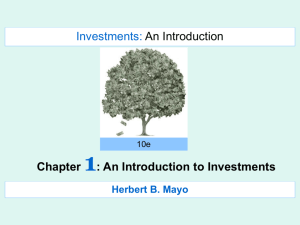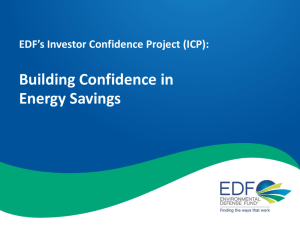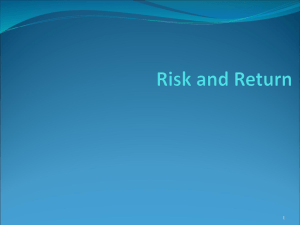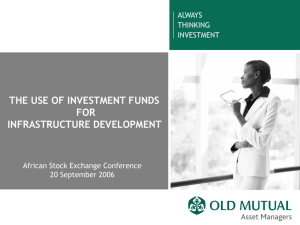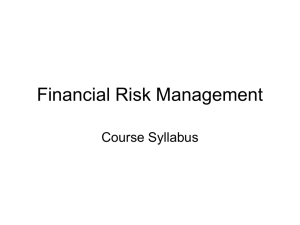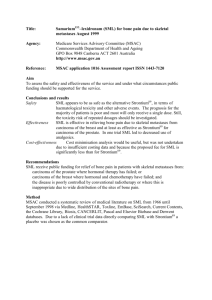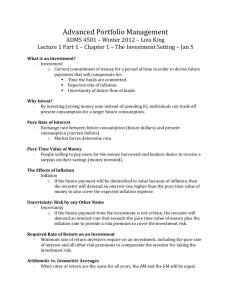Risk and Return
advertisement
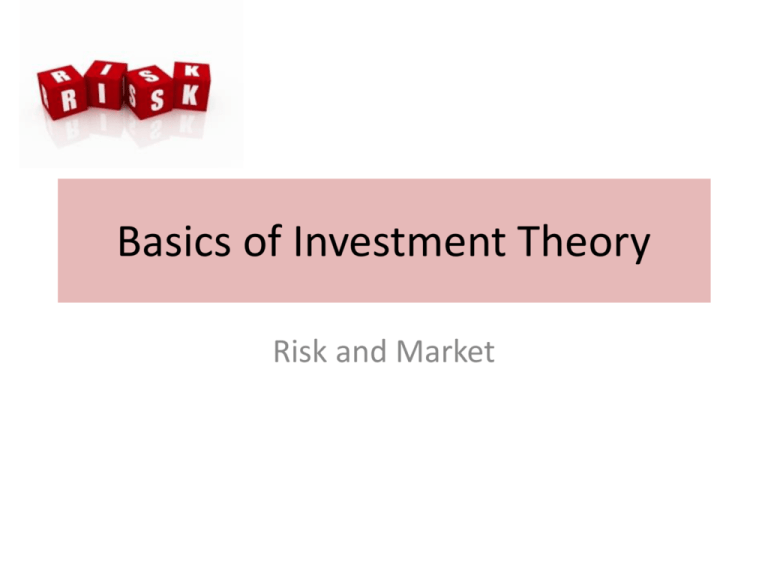
Basics of Investment Theory Risk and Market RISK Risk Premium • An investor typically is not completely certain of the income to be received or when it will be received. • Investments can range in uncertainty from basically risk-free securities, such as T-bills, to highly speculative investments, such as the common stock of small companies engaged in high-risk enterprises. • Most investors require higher rates of return on investments if they perceive that there is any uncertainty about the expected rate of return. • This increase in the required rate of return over the NRFR (Nominal Risk Free Rate) is the risk premium (RP). • Although the required risk premium represents a composite of all uncertainty, it is possible to consider several fundamental sources of uncertainty. Major Sources of Uncertainty: 1.Business risk 2.Financial risk (leverage) 3.Liquidity risk 4.Exchange rate risk, and 5.Country (political) risk Business Risk Business risk • Business risk is the uncertainty of income flows caused by the nature of a firm’s business. • The less certain the income flows of the firm, the less certain the income flows to the investor. • Therefore, the investor will demand a risk premium that is based on the uncertainty caused by the basic business of the firm. • As an example, a retail food company would typically experience stable sales and earnings growth over time and would have low business risk compared to a firm in the auto industry, where sales and earnings fluctuate substantially over the business cycle, implying high business risk. Financial Risk Financial risk • Is the uncertainty introduced by the method by which the firm finances its investments. • If a firm uses only common stock to finance investments, it incurs only business risk. • If a firm borrows money to finance investments, it must pay fixed financing charges (in the form of interest to creditors) prior to providing income to the common stockholders, so the uncertainty of returns to the equity investor increases. • This increase in uncertainty because of fixed-cost financing is called financial risk or financial leverage and causes an increase in the stock’s risk premium. Liquidity Risk Liquidity risk • Is the uncertainty introduced by the secondary market for an investment. • When an investor acquires an asset, he or she expects that the investment will mature (as with a bond) or that it will be salable to someone else. • In either case, the investor expects to be able to convert the security into cash and use the proceeds for current consumption or other investments. • The more difficult it is to make this conversion, the greater the liquidity risk ………. • An investor must consider two questions when assessing the liquidity risk of an investment: (1) How long will it take to convert the investment into cash? (2) How certain is the price to be received? • Similar uncertainty faces an investor who wants to acquire an asset: 1. How long will it take to acquire the asset? 2. How uncertain is the price to be paid? ……….. • Uncertainty regarding how fast an investment can be bought or sold, or the existence of uncertainty about its price, increases liquidity risk. • A government Treasury bill has almost no liquidity risk because it can be bought or sold in minutes at a price almost identical to the quoted price. • In contrast, examples of illiquid investments include a work of art, an antique, or a parcel of real estate in a remote area. For such investments, it may require a long time to find a buyer ………. • Liquidity risk can be a significant consideration when investing in foreign securities depending on the country and the liquidity of its stock and bond markets. Exchange Rate Risk Exchange rate risk • Is the uncertainty of returns to an investor who acquires securities denominated in a currency different from his or her own. • The likelihood of incurring this risk is becoming greater as investors buy and sell assets around the world, as opposed to only assets within their own countries. • A U.S. investor who buys Japanese stock denominated in yen must consider not only the uncertainty of the return in yen but also any change in the exchange value of the yen relative to the U.S. dollar. ……… • That is, in addition to the foreign firm’s business and financial risk and the security’s liquidity risk, the investor must consider the additional uncertainty of the return on this Japanese stock when it is converted from yen to U.S. dollars. • The more volatile the exchange rate between two countries, the less certain you would be regarding the exchange rate, the greater the exchange rate risk, and the larger the exchange rate risk premium you would require. ……. • There can also be exchange rate risk for a U.S. firm that is extensively multinational in terms of sales and components (costs). In this case, the firm’s foreign earnings can be affected by changes in the exchange rate. Country/Political Risk Country risk • Also called political risk, is the uncertainty of returns caused by the possibility of a major change in the political or economic environment of a country. • The United States is acknowledged to have the smallest country risk in the world because its political and economic systems are the most stable. • Individuals who invest in countries that have unstable political-economic systems must add a country risk premium when determining their required rates of return. Summing Up • This discussion of risk components can be considered a security’s fundamental risk because it deals with the intrinsic factors that should affect a security’s standard deviation of returns over time. • The standard deviation of returns is referred to as a measure of the security’s total risk, which considers the individual stock by itself—that is, it is not considered as part of a portfolio. More on Risk • Markowitz and Sharpe indicated that investors should use an external market measure of risk. • Under a specified set of assumptions, all rational, profit maximizing investors want to hold a completely diversified market portfolio of risky assets, and they borrow or lend to arrive at a risk level that is consistent with their risk preferences. • Under these conditions, the relevant risk measure for an individual asset is its co movement with the market portfolio. Systematic and Unsystematic Risk • This co movement, which is measured by an asset’s covariance with the market portfolio, is referred to as an asset’s systematic risk, the portion of an individual asset’s total variance attributable to the variability of the total market portfolio. • In addition, individual assets have variance that is unrelated to the market portfolio (that is, it is nonmarket variance) that is due to the asset’s unique features. • This nonmarket variance is called unsystematic risk, and it is generally considered unimportant because it is eliminated in a large, diversified portfolio. ………. • Therefore, under these assumptions, the risk premium for an individual earning asset is a function of the asset’s systematic risk with the aggregate market portfolio of risky assets. • The measure of an asset’s systematic risk is referred to as its beta: Fundamental Risk versus Systematic Risk • Some might expect a conflict between the market measure of risk (systematic risk) and the fundamental determinants of risk (business risk, and so on). • A number of studies have examined the relationship between the market measure of risk (systematic risk) and accounting variables used to measure the fundamental risk factors, such as business risk, financial risk, and liquidity risk. • The authors of these studies have generally concluded that a significant relationship exists between the market measure of risk and the fundamental measures of risk. ……… • Therefore, the two measures of risk can be complementary. • This consistency seems reasonable because, in a properly functioning capital market, the market measure of the risk should reflect the fundamental risk characteristics of the asset. • As an example, you would expect a firm that has high business risk and financial risk to have an above average beta. ……… • It is possible that a firm that has a high level of fundamental risk and a large standard deviation of return on stock can have a lower level of systematic risk because its variability of earnings and stock price is not related to the aggregate economy or the aggregate market. • Therefore, one can specify the risk premium for an asset as: Change in factors and risk-return co-ordinate Movements along SML • Investors place alternative investments somewhere along the SML based on their perceptions of the risk of the investment. • Obviously, if an investment’s risk changes due to a change in one of its risk sources (business risk, and such), it will move along the SML. • For example, if a firm increases its financial risk by selling a large bond issue that increases its financial leverage, investors will perceive its common stock as riskier and the stock will move up the SML to a higher risk position. ……….. • Investors will then require a higher rate of return. As the common stock becomes riskier, it changes its position on the SML. Any change in an asset that affects its fundamental risk factors or its market risk (that is, its beta) will cause the asset to move along the SML as shown in Exhibit. • Note that the SML does not change, only the position of assets on the SML. Changes in the Slope of the SML • The slope of the SML indicates the return per unit of risk required by all investors. • Assuming a straight line, it is possible to select any point on the SML and compute a risk premium (RP) for an asset through the equation: Market Risk Premium • If a point on the SML is identified as the portfolio that contains all the risky assets in the market (referred to as the market portfolio), it is possible to compute a market RP as follows: ……… • This market RP is not constant because the slope of the SML changes over time. • Although we do not understand completely what causes these changes in the slope, we do know that there are changes in the yield differences between assets with different levels of risk even though the inherent risk differences are relatively constant. ………… • These differences in yields are referred to as yield spreads, and these yield spreads change over time. • As an example, if the yield on a portfolio of Aaa-rated bonds is 7.50 percent and the yield on a portfolio of Baa-rated bonds is 9.00 percent, we would say that the yield spread is 1.50 percent. • This 1.50 percent is referred to as a credit risk premium because the Baa-rated bond is considered to have higher credit risk—that is, greater probability of default. • This Baa–Aaa yield spread is not constant over time. • For an example of changes in a yield spread, note the substantial changes in the yield spreads on Aaa-rated bonds and Baa-rated bonds shown in Exhibit Although the underlying risk factors for the portfolio of bonds in the Aaa-rated bond index and the Baa-rated bond index would probably not change dramatically over time, it is clear from the time-series plot in Exhibit that the difference in yields (i.e., the yield spread) has experienced changes of more than 100 basis points (1 percent) in a short period of time (for example, see the yield spread increase in 1974 to 1975 and the dramatic yield spread decline in 1983 to 1984). Such a significant change in the yield spread during a period where there is no major change in the risk characteristics of Baa bonds relative to Aaa bonds would imply a change in the market RP. Specifically, although the risk levels of the bonds remain relatively constant, investors have changed the yield spreads they demand to accept this relatively constant difference in risk. This change in the RP implies a change in the slope of the SML. Such a change is shown in following Exhibit. The exhibit assumes an increase in the market risk premium, which means an increase in the slope of the market line. Such a change in the slope of the SML (the risk premium) will affect the required rate of return for all risky assets. Irrespective of where an investment is on the original SML, its required rate of return will increase, although its individual risk characteristics remain unchanged. Changes in Capital Market Conditions or Expected Inflation • The graph in following Exhibit shows what happens to the SML when there are changes in one of the following factors: 1. Expected real growth in the economy, 2. Capital market conditions, or 3. The expected rate of inflation. The parallel shift occurs because changes in expected real growth or in capital market conditions or a change in the expected rate of inflation affect all investments, no matter what their levels of risk are. Summary • The relationship between risk and the required rate of return for an investment can change in three ways: 1. A movement along the SML demonstrates a change in the risk characteristics of a specific investment, such as a change in its business risk, its financial risk, or its systematic risk (its beta). This change affects only the individual investment. 2. A change in the slope of the SML occurs in response to a change in the attitudes of investors toward risk. Such a change demonstrates that investors want either higher or lower rates of return for the same risk. This is also described as a change in the market risk premium (Rm – NRFR). A change in the market risk premium will affect all risky investments. 3. A shift in the SML reflects a change in expected real growth, a change in market conditions (such as ease or tightness of money), or a change in the expected rate of inflation. Again, such a change will affect all investments. THE END
